Digital Twin Key to Idaho Shop's Success
Digital Twin Key to Idaho Shop's Success
Even before the supply chain and market disruptions, Scott Harms, president of MetalQuest Unlimited, had plans to expand beyond his company's rural Nebraska origins. Looking for market diversification and a bigger labor pool, this high-volume, high-precision manufacturer of CNC machined parts opened a second location in Post Falls, Idaho in January 2021. The location offers a business-friendly environment, strong economic growth, excellent skilled labor availability, and proximity to new markets in the Pacific Northwest.
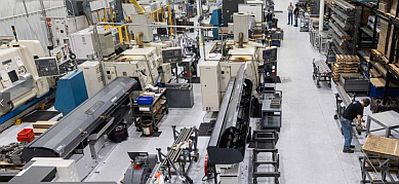
At MetalQuest Unlimited, quality production of component parts is the result of pairing top level operators and the most advanced machinery.
To get things started at the Post Falls facility, the initial equipment list included an Okuma LB CNC lathe, an Okuma M560-V vertical machining center (VMC), a FANUC ROBODRILL VMC, a Tsugami Swiss-style lathe, a SupplyPoint vending system, and a Zoller presetter.
However, the heart of the new facility is an INDEX MS40-8 from INDEX, which the company moved from its Nebraska location. More than just an eight-spindle turning machine with 40 mm bar stock capacity, the MS40-8 has live tools as well as C-axis and Y-axis capabilities that gives MetalQuest access to such processes as off-center drilling and thread cutting, including drilling, cross drilling, contour milling, hobbing for cutting teeth, and polygon turning.
Most importantly, MetalQuest also implemented INDEX's Virtual Machine digital twin software.
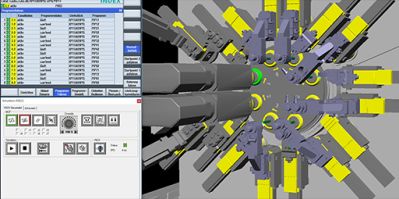
Virtual Machine is a software solution that supports almost all of the functionality of an Index machine tool.
Virtual Machine enables MetalQuest to confirm actual results for every setup before the tool ever touches metal and can remove unproductive time related to programming collisions, changeover, training, and quality control. The results are transformative. From June 2020 through October 2020, the machine made 251,995 complex hydraulic tractor parts, or more than 3,100 parts per day. Smaller than a golf ball, each part has about 70 dimensions.
"We built our new operations around the INDEX because it's a factory in itself," says Chad Oswald, MetalQuest's director of engineering. "It's amazing all the things it can do. We ultimately reduced cycle time on the hydraulic part to 13.1 seconds."
Connecting at IMTS
Using digital manufacturing technology has always been in the forefront of Harms' mind, as the company's location in Hebron, a town of about 1,500 people, makes finding and training staff challenging. As a result, the company implements a high degree of robotics and automation and connects its 30-plus CNCs to its enterprise system via the MTConnect protocol.
Feeling that they were ready to add a high-volume, high-precision machine to their fleet, Harms and Oswald moved forward with the INDEX MS40-8 after keeping abreast of digital twin technology by connecting with INDEX Corporation over the last several IMTS show cycles (Harms has attended every IMTS since 1996, while Oswald has attended since 2000).
"When we connect with INDEX and other exhibitors at the IMTS show, we consistently appreciate how good they are at supporting new technology implementation," says Oswald. "We never would have moved forward with a digital twin without the resources we found at IMTS."
Programming and Training
From a production perspective, the biggest benefit to using a digital twin is proving a setup before ever physically touching a machine and without stopping a production line during programming. It is quicker and more accurate than making calculations and assembling them in a CAD environment.
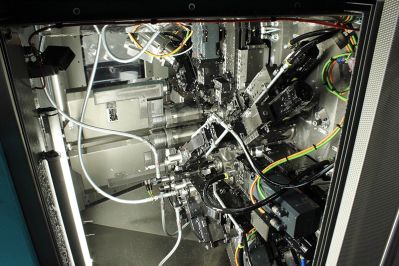
Bringing multiple tools to bear reduces cycle time. Programming on a digital twin enables MetalQuest to check tool offsets and clearances without risking a crash that cuts into production time.
"What we can now do is take the actual G code that will run on the multi-spindle machine and load it into the virtual machine," Oswald says. "We create a program, select the cutting tools, position them on the spindles and check tool offsets and clearances. I can try to run another tool at the same time to take out cycle time. If it crashes digitally because I transposed numbers for an offset, there's no real damage. Further, I can stop the virtual program mid-cut and take three-dimensional measurements to confirm accuracy."
Internationally Competitive
Harms likes the digital twin because it enables the company to train operators while the multi-spindle machine still makes parts.
"When we bring on new team members, Chad can conduct training sessions without being interrupted or disrupting production," Harms says. "Beyond that, we can measure and compare tool wear and track hours of operation, cycle time, and all the data that lets us know how much we invest in putting each part out the door. Digital twin technology is another example of how we stay on the leading edge of manufacturing so that we can compete in the world market."
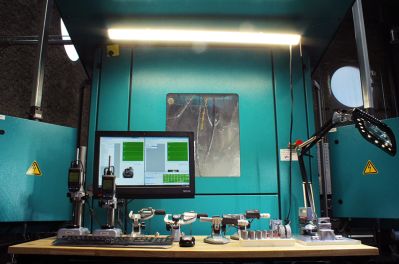
A strategic sampling plan with precision gaging is necessary to keep up with the high-volume output of the INDEX MS40-8. This gage station enables MetalQuest to obtain quick and accurate part measurements.
Competing against overseas companies requires a combination of business strategies, including using advanced technology and pointing out all the factors that contribute to the total cost of a delivered solution.
"We offer a secure and reliable source of high-quality components," says Harms. "Our Post Falls location gets us within easy driving distance of customers in Northern California, Oregon, and Washington, and our use of digital manufacturing technology keeps us in the game, even in highly competitive markets, such as power transmission, hydraulics, and oil field components."
Setup Confidence
Oswald cites an example of winning an order in 2021 to produce about 70,000 muzzle brakes. A muzzle brake connects to the end of a firearm barrel. By directing gases generated by the burning powder through a series of machined ports, it reduces recoil and muzzle movement.
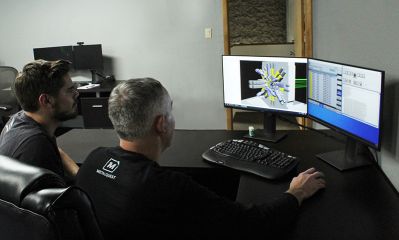
Using Virtual Machine enables MetalQuest Director of Engineering Chad Oswald (at right) to conduct training sessions without interrupting production.
"These are not simple parts," says Oswald. "The first question we had was 'Can we even make the muzzle brake on this machine?' We found that we could, but we used every tool position the machine had. There were a lot of nuances. We ran into clearance problems we never expected. We ran into part length problems. However, we solved all those issues well in advance while the machine was still making parts."
As he has gained experience with the digital twin over the last year, Oswald has thought a lot about how it differs from a CAM system. He believes that, while CAM vendors do their best to simulate a particular machine model, the post-processed G code has no direct connection to the CAM simulation.
"A digital twin is as close of a simulation to the real world as you're ever going to get, right down to our machine's serial number. That was a huge advantage," he explains. "To make a simulation work, we have to take steps identical to those we take in the real world. Doing it digitally ahead of time is painstaking at some points, but with the muzzle brake, it gave us a huge sense of confidence when we hit the shop floor."
[This article, written by AMT's Managing Editor Kathy Webster, first appeared in the IMTS Insider.]
Want more information? Click below.
Rate this article
View our terms of use and privacy policy